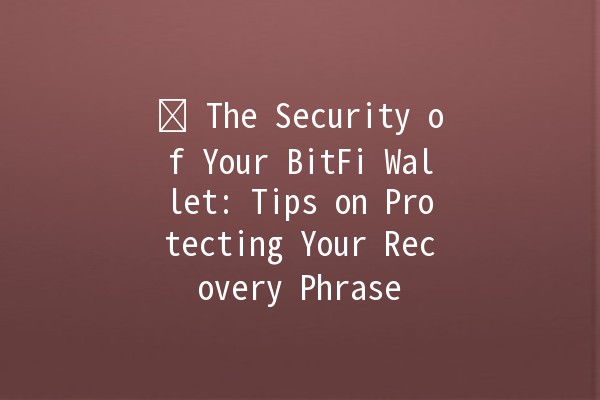
In an age where digital assets are becoming essential to our financial lives, the security of wallets that store these assets is paramount. Specifically, the BitFi wallet stands out for its userfriendly interface and solid security features. However, no matter how welldesigned a wallet may be, your protection begins and ends with the management of your recovery phrase. This article provides actionable tips for safeguarding this critical piece of information, ensuring your cryptocurrency remains secure.
Understanding What a Recovery Phrase Is
A recovery phrase, often referred to as a seed phrase, is a humanreadable representation of your wallet's private key. This series of randomly generated words allows you to restore your wallet and access your funds in case your device is lost, stolen, or damaged. For many cryptocurrency holders, the recovery phrase is the single most important piece of information to protect. Knowing how to manage it wisely is crucial for maintaining the integrity of your digital assets.
Tip 1: Write It Down and Store It Safely
The first and most vital step is to physically write down your recovery phrase. Digital forms, whether in text files or cloud storage, can be hacked or corrupted. Instead, opt for pen and paper:
Use a Durable Medium: Consider using specialized writing material like a metal plate designed for seed phrases. Such materials can withstand fire, water, and decay, offering enhanced durability.
Multiple Copies: Make several copies of your recovery phrase and store them in different locations. This way, if one copy is lost or destroyed, you’ll have backups.

Secure Location: Keep these physical copies in secure and locations, such as a safe or safety deposit box.
Example Application:
Alice, an avid cryptocurrency trader, writes down her recovery phrase on a metal plate and keeps one copy in her home safe and another in her bank's safety deposit box. By opting for a durable medium and multiple locations, she significantly reduces the risk of losing access to her funds.
Tip 2: Use Strong Passwords and TwoFactor Authentication (2FA)
While your recovery phrase secures your wallet, a strong password adds an additional layer of protection to your account:
Create a Unique Password: Your password should not be something easily guessable like birthdays or names. Instead, use a combination of upper and lowercase letters, numbers, and special characters.
Implement 2FA: Whenever possible, enable TwoFactor Authentication. It requires a second method of verifying your identity, usually via text or an authentication app, making unauthorized access significantly harder.
Example Application:
Bob ensures that his BitFi wallet is secured with a strong, unique password and has 2FA enabled. When someone attempts to access his account from a different device, they cannot proceed without the verification code sent to Bob's phone.
Tip 3: Be Wary of Phishing Attempts
Phishing is a common tactic used by cybercriminals to obtain sensitive information such as your recovery phrase:
Verify URLs: Always check the URL before entering any sensitive information. Official sites have SSL certificates (the URL begins with HTTPS) and are typically followed by the official domain.
Never Share Your Recovery Phrase: If anyone asks for your recovery phrase, ignore them. No legitimate service will ever ask for this information.
Example Application:
Clara receives an email that looks like it’s from BitFi, asking her to confirm her recovery phrase. She checks the URL and realizes it leads to a suspicious site. Recognizing the phishing attempt, she avoids entering her information and immediately reports it.
Tip 4: Regularly Update Your Security Practices
Like any other technology, security practices should evolve:
Review Regularly: Routinely check your security settings and practices. This includes updating passwords and ensuring that your devices are free of malware.
Stay Informed: Follow reputable online resources or communities to stay updated about potential threats, phishing scams, or updates related to the BitFi wallet.
Example Application:
David schedules monthly reviews of his crypto security practices. During one of these reviews, he discovers a software update for his wallet and promptly installs it, enhancing his wallet’s security features.
Tip 5: Educate Yourself about New Technologies and Trends
The cryptocurrency landscape frequently changes, and staying informed can prevent security mishaps:
Follow Trends: Subscribe to accounting or security blogs specific to cryptocurrency or wallet usage. Familiarize yourself with common types of scams and newer security trends.
Participate in Webinars and Workshops: Look for online seminars focused on cryptocurrency security. Engaging with experts and users can provide valuable insights and tips.
Example Application:
Emma regularly attends webinars about cryptocurrency security. One session discusses recent trends in smart contracts and shows how to avoid specific scams. She implements this knowledge, ensuring her investments remain secure.
Common Questions About Recovery Phrase Security
Losing your recovery phrase means you may lose access to your funds permanently. Unlike a bank, there is no recovery option. This is why backing it up in multiple secure places is recommended.
Generally, recovery phrases are generated during wallet setup and cannot be changed. If you want a new recovery phrase, you may need to create a new wallet and transfer your funds.
Storing your recovery phrase online is generally not safe, as it is vulnerable to hacking. Always use physical storage methods and avoid cloud services.
Signs of compromise include unusual transactions that you did not authorize, difficulty accessing your wallet, or receiving unexpected requests for sensitive information. If you suspect a breach, act quickly to secure your assets.
No, never share your recovery phrase, even with trusted individuals. Legitimate support services will never ask for such information.
It is best to review your wallet security practices regularly, ideally at least once a month, and keep abreast of the latest developments in the cryptocurrency realm.
By implementing these strategies, you can significantly bolster the security of your BitFi wallet and ensure your recovery phrase remains confidential and safe from potential threats. Whether you are a seasoned trader or just starting, securing your recovery phrase is essential in today's digital landscape. Follow these tips, stay informed, and take control of your cryptocurrency assets.

